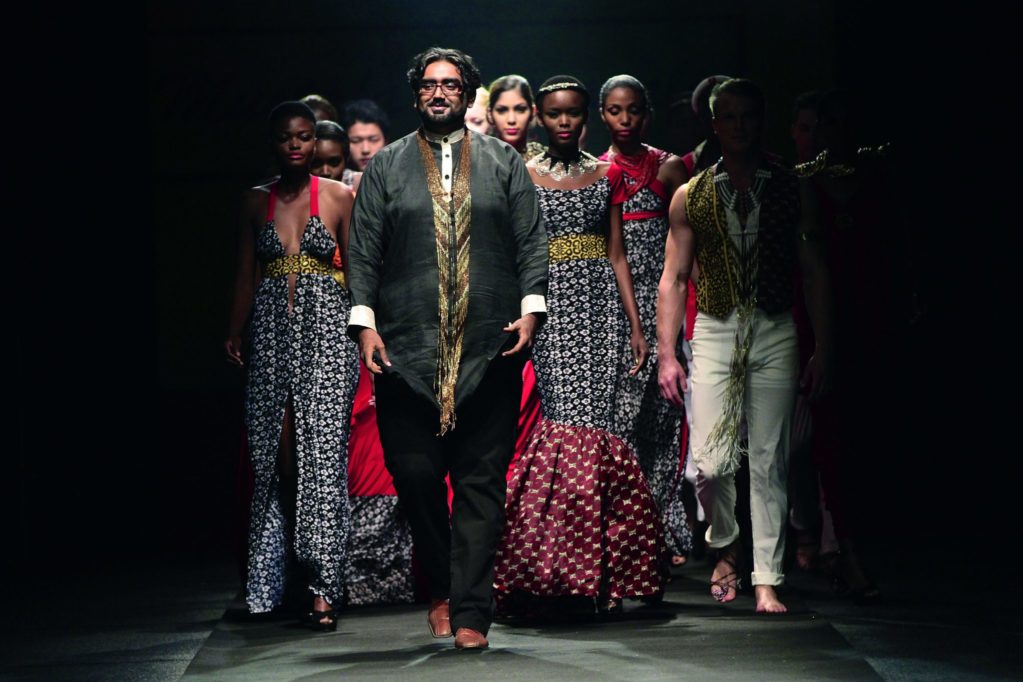Every designer has a list of celebrities they’re dying to dress. The star-studded names on Tanzanian fashion designer Mustafa Hassanali’s list included: Princess Diana, Bollywood star Aishwarya Rai Bachchan, Queen Rania Al Abdullah of Jordan, Oprah Winfrey and Naomi Campbell, who he worked with in 2009 for her Fashion for Relief campaign.
Working with Campbell was one of the highlights of Hassanali’s career, one that began more than 15 years ago.
“She’s awesome; she has the most amazing skin. When you do fittings, you normally leave it to your staff, but for that one I had to be there.”
Campbell is infamous for her tantrums, punching cameras, hitting housekeepers and throwing cellphones at her assistants. So, before she arrived, Hassanali made sure he was prepared.
“I was planning how I was going to catch the phone if she threw it at me. I decided that, if she did, I was going to keep it and I wouldn’t sue her,” he says.
Loading...
Luckily the British supermodel was on her best behavior.
As a young boy, Hassanali would rather stay indoors and make clothes for his paper dolls than play outside in the mud with the other children. As he got older, his skills with the needle and thread improved and he began making prayer mats with matching handbags for his family.
Hassanali was the only boy in a conservative Indian household. Although he had a great passion for fashion and design, society did not perceive it as a proper career. He was expected to become a doctor, get married and carry on the Indian family traditions.
Everything seemed to be going according to plan. Hassanali was studying medicine at the University of Dar es Salaam and to make extra money he made clothes for his peers.
His breakthrough came in 1999 when the 19-year-old made a dress for Hoyce Temu, one of the finalists for the Miss Tanzania pageant. Temu was crowned in Hassanali’s design and suddenly everyone wanted to work with him.
Then tragedy struck.
“My parents died, one after the other,” he says.
Hassanali began designing more frequently and used the money to continue his medical studies. At the end of his studies, he chose fashion over medicine.
In 2002, he had the chance to show his work at Kenya Fashion Week. But his lack of formal training in fashion made him feel like a fish out of water.
“It was like taking a person from a village and placing them in the middle of New York’s Times Square. They’re from a village with no cars, no light, no electricity, no running water and they go crazy.”
Since then, Hassanali pledged to learn everything he could about the industry, from telling a story with his designs to constructing his own stages. Over the years, he has worked hard to keep the essence of his designs the same. He works with a lot of traditional Tanzanian fabrics with kitenge colors.
“I do a lot of structure, silhouette gowns and a lot of flowy gowns. There has to be bling and most of my gowns have trains,” he says.
In 2007, Hassanali created Swahili Fashion Week as a platform for younger designers from Swahili-speaking countries to launch their careers. He wanted to give them opportunities he never had.
“It took me so long to build the brand. No money, no resources, nobody to guide me. So you basically fight your own battles. Your family does not support you and the people in the community do not support you. You could say my marriage broke because of it,” says Hassanali.
In his entire career, he has never won a single award and often finds it hard to see how quickly the young designers receive so much recognition and praise these days.
“[For the younger designers] if you can put your resources together, showcase a collection and if you’re good, then suddenly everyone will start noticing you. But the older designers really struggled… They might be big names today but the journey took so long.”
During difficult times, Hassanali stays grounded in his seven life philosophies: passion, patience, persistence, productivity, professionalism, principles and prayer.
Being a well-known African designer who has showcased in 27 cities and 18 countries, he still feels he has much to learn. One of his biggest dreams is to work with internationally renowned designer, Elie Saab.
“I wish I could have him dress me, that would be a dream come true. I hope I will have the chance to just work with him or even sweep floors for him for a month or two, just to know what’s happening and how they work in the global world.”
Before he expands into the global market, he wants to make sure he has fully catered to the Tanzanian market.
“East Africa has about 150 million people. If you get 0.001 percent of it in East Africa you still have 15,000 clientele. Their needs have not been satisfied. The thought of going outside the country doesn’t make sense, first you have to satisfy the needs of the country.”
In the next few years, Hassanali hopes to open a few stores and launch a shoe collection.
“Nothing less than six inches,” he says.
Having spent six years at medical school to receive a degree he never used, Hassanali’s advice to the youth is simple: Find what you love to do, make a career out of it and the money will follow.
Loading...
